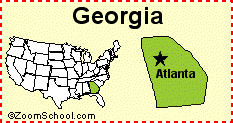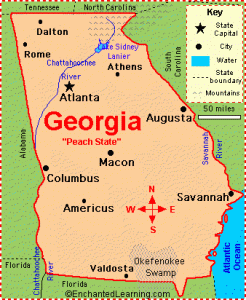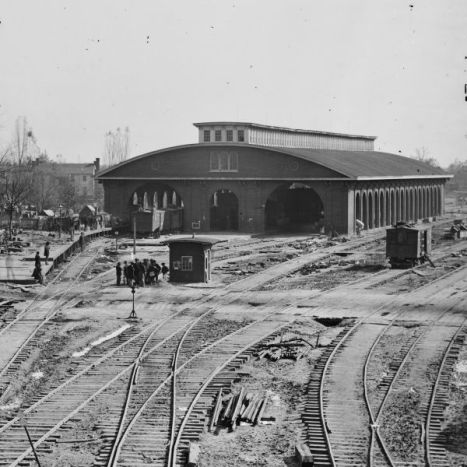The British colony of Georgia (named for King George II) was founded by James Oglethorpe in February, 1733.
Georgia was one of the original Thirteen Colonies that revolted against British rule in the American Revolution by signing the 1776 Declaration of Independence. The State of Georgia’s first constitution was ratified in February 1777. Georgia ratified the Articles of Confederation in 1778, and on this day in history, it became the 4th state to ratify the current U.S. Constitution. However, it later declared its secession from the Union on January 19, 1861 as one of the original seven Confederate states. It was the last state to be restored to the Union, on July 15, 1870.
Throughout Georgia’s history, its capital has moved four times. The cities of Savannah, Augusta, Louisville, Milledgeville and Atlanta have all at one point served as the seat of state government.
Many assume that Atlanta was Georgia’s capital during the Civil War, but in fact it was still Milledgeville, as it had been since 1804.
Atlanta got its start as the terminus of the Western and Atlantic Railroad intended to link up the port of Savannah with the Midwest. A year after the “zero milepost” was driven into the ground, the area around it had developed into a settlement, known first as “Terminus.” Later the name was changed to “Thrasherville” after a local merchant who built homes and a general store in the area. By 1842, the town had grown to six buildings and 30 residents, and changed its name again, this time to “Marthasville” after the Governor’s daughter. J. Edgar Thomson, Chief Engineer of the Georgia Railroad, suggested the town be renamed once again as “Atlantica-Pacifica,” which was shortened to “Atlanta.” With approval of the residents, the town was incorporated as Atlanta on December 29, 1847.
By 1860, Atlanta’s population had grown to 9,554, but it was still mainly just a railroad junction and regional market town. The Civil War, however, transformed the city. Soon the factories that had served the railroads began to turn out armaments and munitions, uniforms and armor plating. Soldiers and refugees arrived en masse into the city, as did those who wanted to help them.
As the Union Army made its way to the southeast, the area around Atlanta became a battlefield. On September 1, 1864, Confederate General John Bell Hood decided to retreat from Atlanta, ordering all public buildings and possible assets to the Union Army destroyed. The next day, Mayor James Calhoun surrendered Atlanta to the Union Army, and on September 7, General Sherman ordered the city’s civilian population to evacuate. On November 11, 1864, in preparation of the Union Army’s march to Savannah, Sherman ordered Atlanta to be burned to the ground, sparing only the city’s churches and hospitals.
After the Civil War ended in 1865, Atlanta was gradually rebuilt. By this time, there were many who wanted to return there, and it still had a superior rail transportation network. Thus the state capital was moved to Atlanta from Milledgeville in 1868. By 1880, Atlanta’s population surpassed that of Savannah.
Over seventy streets in metro Atlanta are named Peachtree, and many of them intersect with one another. You might think this is because Georgia is the top peach producer in the U.S. But Atlanta grew on a site occupied by the Creek people, which included a major village called Standing Peachtree. Historians dispute whether the Creek settlement was called Standing Peachtree or Standing Pitch Tree, corrupted later to peach. The Creek Indians used the pitch, or sap, from area pine trees for ceremonies.
Not far from Atlanta is Stone Mountain. This is the site of the largest high relief sculpture in the world, the Confederate Memorial Carving, which depicts three Confederate heroes of the Civil War – President Jefferson Davis, General Robert E. Lee, and General Thomas J. “Stonewall” Jackson. The entire carved surface measures three-acres.
The original sculptor hired in 1915, Gutzon Borglum, left after a dispute and went on to carve Mount Rushmore. A second carver resumed work in 1925 but the management company ran out of funds in 1928. The mountain remained untouched for 36 years.
In 1958 the state of Georgia purchased the mountain and the surrounding land. In 1963, the Stone Mountain Memorial Association chose a sculptor to complete the carving and work resumed in 1964. The work was completed relatively quickly because of the use of thermo-jet torches to carve away the granite. Finishing touches were completed in 1972.
Stone Mountain is also known as the site of the revival of The Ku Klux Klan in 1915. Martin Luther King, Jr.’s “I Have a Dream” speech on August 28, 1963 consequently includes the line “let freedom ring from Stone Mountain of Georgia.”
There have been more than 50 songs recorded about Georgia, including “The Devil Went Down to Georgia,” “Sweet Georgia Brown,” “The Night the Lights Went Out in Georgia,” and “Georgia on My Mind, which became the official state song of the State of Georgia in 1979. “Georgia on My Mind” is ranked #44 on Rolling Stone’s 500 Greatest Songs of All Time.
Filed under: History, legal | Tagged: Georgia, History, legal |










Leave a comment